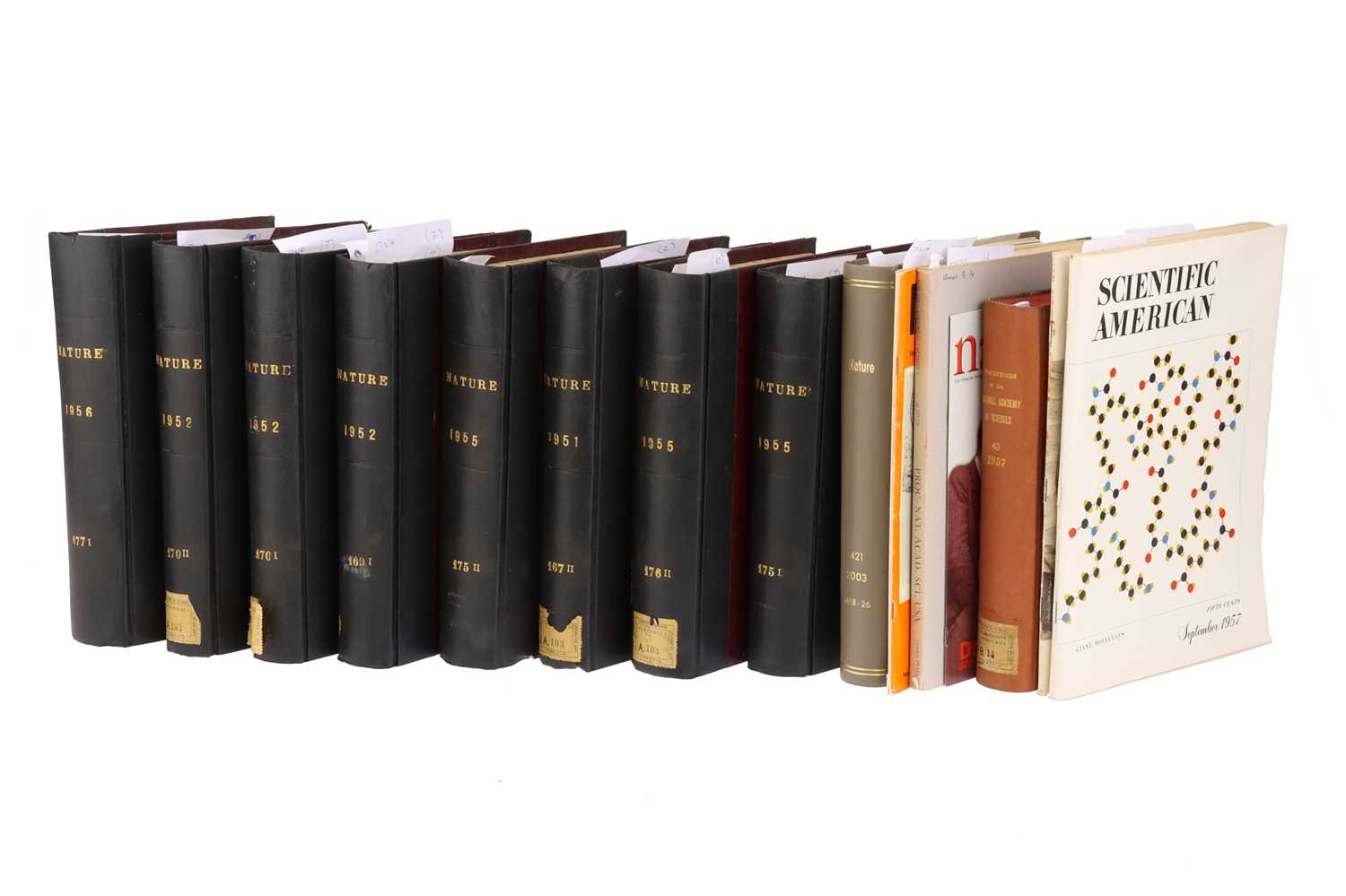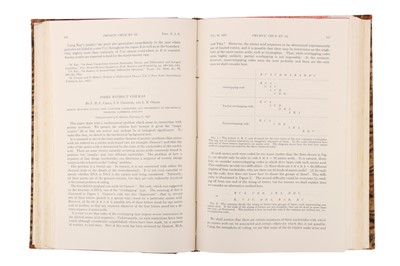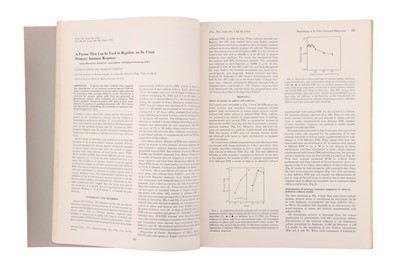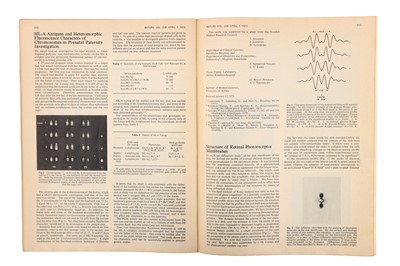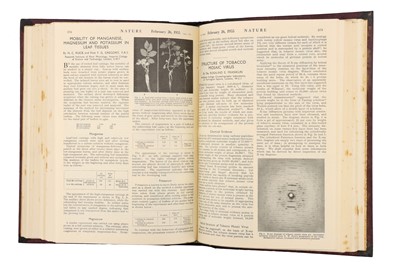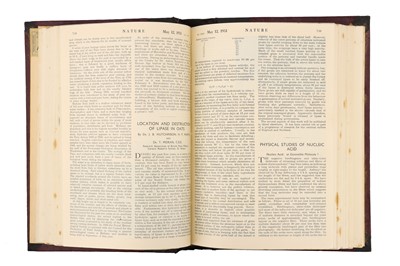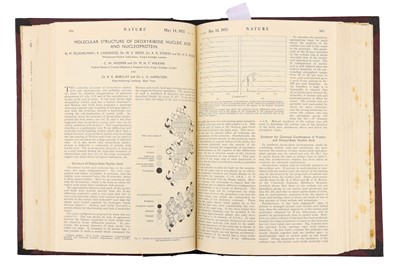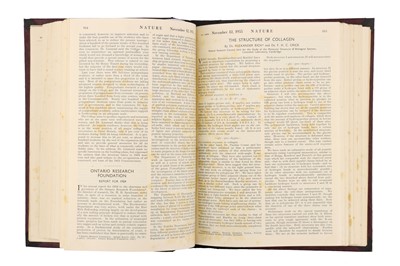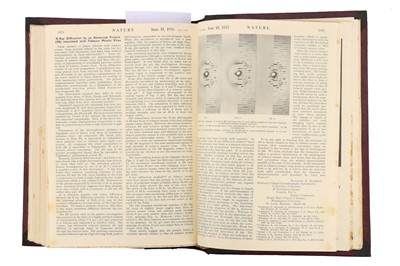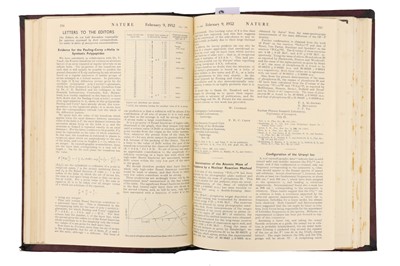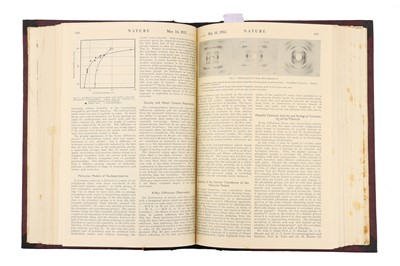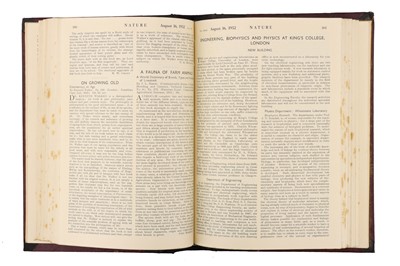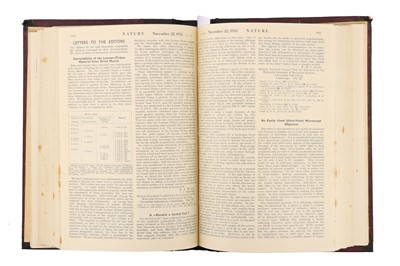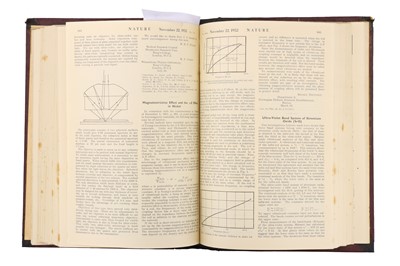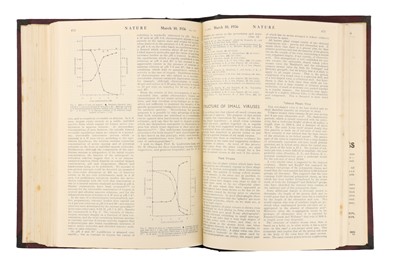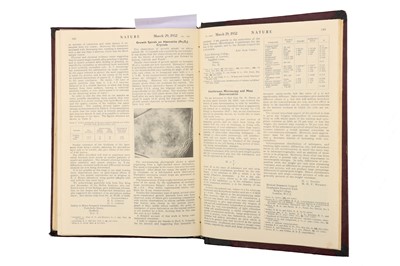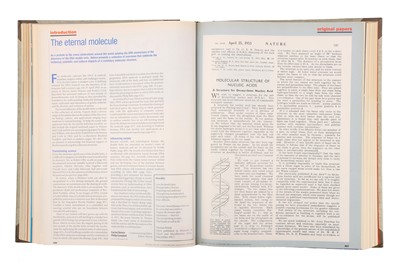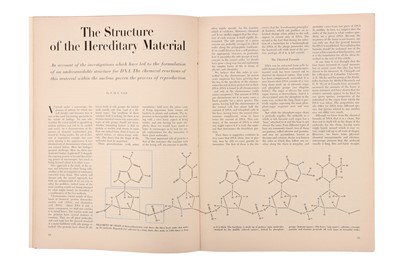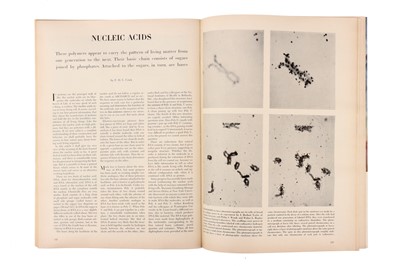24th May, 2023 12:00
Fine Instruments of Science, Medicine and Books
An Important Collection of 17 Period Articles Documenting the Discovery of DNA
An important collection of 14 papers documenting one of the most important scientific milestones of the twentieth century, recording the discovery of the molecular structure of deoxyribonucleic acid (DNA), the early research that lead to its discovery as well as later papers on the DNA, the main component of chromosomes and the material that transfers genetic characteristics in all life forms.
Forty years after Watson and Crick's discovery, so much of the basic understanding of medicine and disease has advanced to the molecular level that their paper may be considered the most significant single contribution to biology and medicine in the twentieth century" (One Hundred Books Famous in Medicine, p. 362). The double helix describing the molecular structure of DNA has not only reshaped biology, it has become a cultural icon, represented in sculpture, visual art, jewellery, and toys. In 1962, Watson, Crick, and Wilkins shared the Nobel Prize in Physiology or Medicine "for their discoveries concerning the molecular structure of nucleic acids and its significance for information transfer in living material."
By the early 1950s the DNA had become one of the most important questions in biology. Maurice Wilkins of King's College London and his colleague Rosalind Franklin were both working on DNA, with Franklin producing X-ray diffraction images of its structure. Wilkins also introduced his friend Francis Crick to the subject, and Crick and his partner James Watson began their own investigation at the Cavendish Laboratory in Cambridge, focusing on building molecular models. After one failed attempt in which they postulated a triple-helix structure, they were banned by the Cavendish from spending any additional time on the subject. But a year later, after seeing new X-ray diffraction images taken by Franklin (notably the famous 'Photo 51', which is reproduced in the third paper), they resumed their work and soon announced that not only had they discovered the double-helix structure of DNA, but even more importantly, that "the specific pairing we have postulated immediately suggests a possible copying mechanism for the genetic material."
1.- A structure for deoxyribose acid, and Molecular structure of deoxypentose nucleic acids, and Molecular configuration in sodium thymonucleate. Watson, Crick, Wilkins, Franklin, et al. Milestone articles from Nature 1953, vol 171, in The double helix – 50 years. Nature 2003, vol 421. Volume bound with original wrappers and adds in all issues
2.- Physical studies of nucleic acid. Nucleic acid: an extensible molecule? Nature 1951 vol 167 bound with original wrappers and adds in all issues. Pp 759. Wilkins, Gosling.
3.- Evidence of the Pauling-Corey α-Helix in synthetic polypeptases. Nature 1952 Vol 169 bound with original wrappers and adds in all issues. Pp 234. Crick.
4.- Interference microscopy and mass determination. Nature 1952 vol 169 bound with original wrappers and adds in all issues. Pp 541. Wilkins.
5.- Is α-keratin a coiled coil? Nature 1952 vol 170 bound with original wrappers and adds in all issues. Pp 882. Crick.
6.- An easily used ultra-violet microscope objective. Nature 1952 vol 170 bound with original wrappers and adds in all issues. Pp 883. Wilkins.
7.- Engineering, biophysics and physics at King´s College, London. Nature 1952 vol 170 bound with original wrappers and adds in all issues. Pp 261. Wilkins.
8.- Molecular structure of deoxyribose nucleic acid and nucleoprotein. Nature 1955 vol 175 bound with original wrappers and adds in all issues. Pp 834. Wilkins, Stokes, et al.
9.- Structure of tobacco mosaic virus. Nature 1955. Vol 175 bound with original wrappers and adds in all issues. Pp 379. Franklin.
10.- Structure of polyglycine II. Nature 1955. Vol 176 bound with original wrappers and adds in all issues. Pp 780. Crick.
11.- The structure of collagen. Nature 1955. Vol 176 bound with original wrappers and adds in all issues. Pp 915. Crick.
12.- Structure of small viruses. Nature 1956. Vol 177 bound with original wrappers and adds in all issues. Pp 473. Crick and Watson.
13.- Structure of tobacco mosaic virus: Location of the ribonucleic acid in the tobacco mosaic virus particle. Nature 1956. Vol 177 bound with original wrappers and adds in all issues. Pp 928. Franklin R, E.
14 - Codes Without Commas, bound copy of Proceedings of the National Academy of Sciences of the United States of America, vol.43 no.5 1957,by F. H. C. Crick, J. S. Grifith and L. E. Orgel
15.- Structure of retinal photoreceptor membranes. Nature 1972. Vol 236. Pp 313, Complete journal, Original wrappers and adds. Strangeways labs, Cambridge, England.
16 - A Factor that can be used to Regulate an In Vitro Primary Imune Response, Proceedings of the National Academy of Sciences of the United States of America, vol.69, No.3 March 1972 ,by James Watson and Marilyn Toman
17 - Double Helix 50th Aniversary Collection, Nature, reprint of the classic papers from Nature 25th April 1953
Sold for £5,000
Result including buyers premium
An important collection of 14 papers documenting one of the most important scientific milestones of the twentieth century, recording the discovery of the molecular structure of deoxyribonucleic acid (DNA), the early research that lead to its discovery as well as later papers on the DNA, the main component of chromosomes and the material that transfers genetic characteristics in all life forms.
Forty years after Watson and Crick's discovery, so much of the basic understanding of medicine and disease has advanced to the molecular level that their paper may be considered the most significant single contribution to biology and medicine in the twentieth century" (One Hundred Books Famous in Medicine, p. 362). The double helix describing the molecular structure of DNA has not only reshaped biology, it has become a cultural icon, represented in sculpture, visual art, jewellery, and toys. In 1962, Watson, Crick, and Wilkins shared the Nobel Prize in Physiology or Medicine "for their discoveries concerning the molecular structure of nucleic acids and its significance for information transfer in living material."
By the early 1950s the DNA had become one of the most important questions in biology. Maurice Wilkins of King's College London and his colleague Rosalind Franklin were both working on DNA, with Franklin producing X-ray diffraction images of its structure. Wilkins also introduced his friend Francis Crick to the subject, and Crick and his partner James Watson began their own investigation at the Cavendish Laboratory in Cambridge, focusing on building molecular models. After one failed attempt in which they postulated a triple-helix structure, they were banned by the Cavendish from spending any additional time on the subject. But a year later, after seeing new X-ray diffraction images taken by Franklin (notably the famous 'Photo 51', which is reproduced in the third paper), they resumed their work and soon announced that not only had they discovered the double-helix structure of DNA, but even more importantly, that "the specific pairing we have postulated immediately suggests a possible copying mechanism for the genetic material."
1.- A structure for deoxyribose acid, and Molecular structure of deoxypentose nucleic acids, and Molecular configuration in sodium thymonucleate. Watson, Crick, Wilkins, Franklin, et al. Milestone articles from Nature 1953, vol 171, in The double helix – 50 years. Nature 2003, vol 421. Volume bound with original wrappers and adds in all issues
2.- Physical studies of nucleic acid. Nucleic acid: an extensible molecule? Nature 1951 vol 167 bound with original wrappers and adds in all issues. Pp 759. Wilkins, Gosling.
3.- Evidence of the Pauling-Corey α-Helix in synthetic polypeptases. Nature 1952 Vol 169 bound with original wrappers and adds in all issues. Pp 234. Crick.
4.- Interference microscopy and mass determination. Nature 1952 vol 169 bound with original wrappers and adds in all issues. Pp 541. Wilkins.
5.- Is α-keratin a coiled coil? Nature 1952 vol 170 bound with original wrappers and adds in all issues. Pp 882. Crick.
6.- An easily used ultra-violet microscope objective. Nature 1952 vol 170 bound with original wrappers and adds in all issues. Pp 883. Wilkins.
7.- Engineering, biophysics and physics at King´s College, London. Nature 1952 vol 170 bound with original wrappers and adds in all issues. Pp 261. Wilkins.
8.- Molecular structure of deoxyribose nucleic acid and nucleoprotein. Nature 1955 vol 175 bound with original wrappers and adds in all issues. Pp 834. Wilkins, Stokes, et al.
9.- Structure of tobacco mosaic virus. Nature 1955. Vol 175 bound with original wrappers and adds in all issues. Pp 379. Franklin.
10.- Structure of polyglycine II. Nature 1955. Vol 176 bound with original wrappers and adds in all issues. Pp 780. Crick.
11.- The structure of collagen. Nature 1955. Vol 176 bound with original wrappers and adds in all issues. Pp 915. Crick.
12.- Structure of small viruses. Nature 1956. Vol 177 bound with original wrappers and adds in all issues. Pp 473. Crick and Watson.
13.- Structure of tobacco mosaic virus: Location of the ribonucleic acid in the tobacco mosaic virus particle. Nature 1956. Vol 177 bound with original wrappers and adds in all issues. Pp 928. Franklin R, E.
14 - Codes Without Commas, bound copy of Proceedings of the National Academy of Sciences of the United States of America, vol.43 no.5 1957,by F. H. C. Crick, J. S. Grifith and L. E. Orgel
15.- Structure of retinal photoreceptor membranes. Nature 1972. Vol 236. Pp 313, Complete journal, Original wrappers and adds. Strangeways labs, Cambridge, England.
16 - A Factor that can be used to Regulate an In Vitro Primary Imune Response, Proceedings of the National Academy of Sciences of the United States of America, vol.69, No.3 March 1972 ,by James Watson and Marilyn Toman
17 - Double Helix 50th Aniversary Collection, Nature, reprint of the classic papers from Nature 25th April 1953
